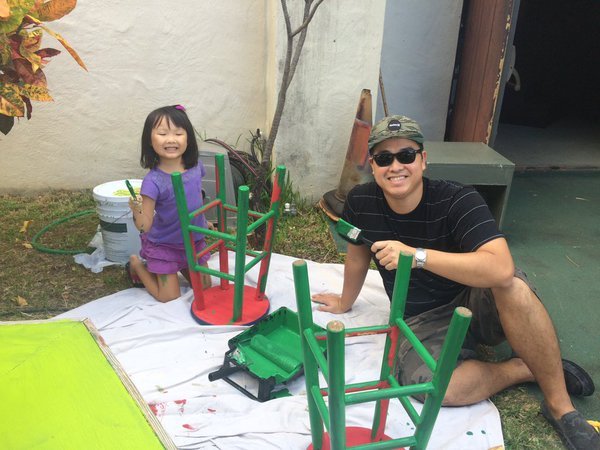VOLUNTEER WORK, SUCH AS PAINTING HONOLULU THEATRE FOR YOUTH SCENERY AT HONOLULU FAMILYʻS VOLUNTEER DAY, CAN TEACH KIDS (AND PARENTS) TO THINK BEYOND THEIR OWN NEEDS.
Photo credit: GETTY IMAGES
I have high hopes for my children, as most parents do. We’d like them to be smart, driven and talented. We want them to travel the world, cure cancer, invent a new technology and experience many wonderful adventures along the way.
While we all want our kids to achieve greatness, it’s even more important that they grow up to be kind and compassionate individuals.
Raising a compassionate child—one who treats friends with kindness, is generous with strangers and shows respect for the world around him or her—can sometimes seem like a tall order. If you have a toddler who refuses to share or pulls the dog’s tail at every opportunity, you may be wondering how to right the ship and raise a more empathetic child.
Rest assured, many experts agree that keiki have an innate capacity for empathy and compassion. Very young children have limited impulse control and find it hard to put anyone else’s needs before their own, but as they grow, they’ll develop the ability to empathize with others.
By the time children are around 4 years of age, they can understand and feel sorry when they’ve hurt someone. They can also empathize with others who are injured or sad. By 5 or 6, children are more willing to share and take turns with each other, or take action to be kind to their peers or siblings.
Here in Hawai‘i, we’re fortunate to have many values instilled in local culture that go hand in hand with raising a compassionate child. The concept of mālama (to care for or tend) is easily taught by picking up trash at the beach, even if it isn’t your own. Your children will learn kuleana (responsibility) by volunteering as a family to feed the homeless or donating old toys and clothes to Goodwill.
Teaching compassion starts at home. Your child will look to you for lessons on how to treat others. Encourage empathy in your children by treating everyone with aloha, from your spouse to your child’s teacher to the cashier at the supermarket.
How to Get Started
Model compassionate behavior. This may mean physically demonstrating an action, such as taking your child’s hand and showing him how to pet the dog gently. It also means being kind to the people around you, such as showing patience and understanding to a waiter who gets your order wrong.
Praise compassionate behavior. When you see your child sharing her snack with someone, let her know you value her actions by saying, “That was thoughtful of you to share” or “You’re a kind friend.” On the other hand, overpraising can end up being a distraction. Your child should be expected to say please and thank you or help out around the house, so it can actually be detrimental when they end up expecting praise for every small action.
Talk about feelings. When your child becomes frustrated that she can’t complete a task, or excited about an upcoming trip, talk about her feelings and give them a name. You can also ask your child to name the emotions of characters in books you’re reading. By exploring and discussing feelings, your child will learn how to identify their emotions and the emotions of people around them, making it easier to empathize with others.
Ryan Kusumoto is president of Parents And Children Together, a leading Hawai‘i nonprofit providing social services and early childhood education to nurture the relationships that matter most for children and families.
Parents And Children Together is partnering with HONOLULU Family in a series of articles on creating safe and promising futures for Hawaii’s children and families.


